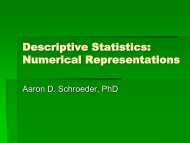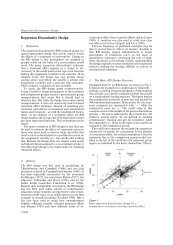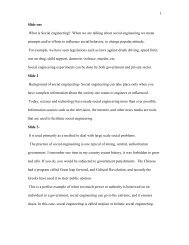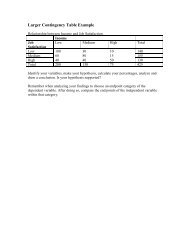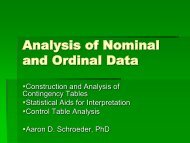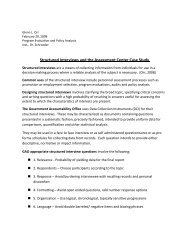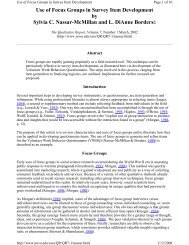The CIPP approach to evaluation
The CIPP approach to evaluation
The CIPP approach to evaluation
Create successful ePaper yourself
Turn your PDF publications into a flip-book with our unique Google optimized e-Paper software.
<strong>The</strong> <strong>CIPP</strong> <strong>approach</strong> <strong>to</strong> <strong>evaluation</strong><br />
COLLIT project: A background note from Bernadette Robinson<br />
4 May 2002<br />
<strong>The</strong> COLLIT project <strong>evaluation</strong> is based on the <strong>CIPP</strong> model, adapted for the project by Judith<br />
Calder. This note is intended <strong>to</strong> provide some background information on the <strong>approach</strong>.<br />
What is <strong>CIPP</strong>?<br />
<strong>The</strong> <strong>CIPP</strong> model of <strong>evaluation</strong> was developed by Daniel Stufflebeam and colleagues in the 1960s,<br />
out of their experience of evaluating education projects for the Ohio Public Schools District.<br />
Stufflebeam, formerly at Ohio State University, is now Direc<strong>to</strong>r of the Evaluation Centre, Western<br />
Michigan University, Kalamazoo, Michigan, USA. <strong>CIPP</strong> is an acronym for Context, Input, Process<br />
and Product. This <strong>evaluation</strong> model requires the <strong>evaluation</strong> of context, input, process and product<br />
in judging a programme’s value.<br />
<strong>CIPP</strong> is a decision-focused <strong>approach</strong> <strong>to</strong> <strong>evaluation</strong> and emphasises the systematic provision of<br />
information for programme management and operation. In this <strong>approach</strong>, information is seen as<br />
most valuable when it helps programme managers <strong>to</strong> make better decisions, so <strong>evaluation</strong><br />
activities should be planned <strong>to</strong> coordinate with the decision needs of programme staff. Data<br />
collection and reporting are then undertaken in order <strong>to</strong> promote more effective programme<br />
management. Since programmes change as they are implemented, decision-makers needs will<br />
change so the <strong>evaluation</strong> activities have <strong>to</strong> adapt <strong>to</strong> meet these changing needs as well as<br />
ensuring continuity of focus where appropriate in order <strong>to</strong> trace development and performance over<br />
time.<br />
<strong>The</strong> <strong>CIPP</strong> framework was developed as a means of linking <strong>evaluation</strong> with programme decisionmaking.<br />
It aims <strong>to</strong> provide an analytic and rational basis for programme decision-making, based on<br />
a cycle of planning, structuring, implementing and reviewing and revising decisions, each examined<br />
through a different aspect of <strong>evaluation</strong> –context, input, process and product <strong>evaluation</strong>.<br />
Stufflebeam viewed <strong>evaluation</strong> in terms of the types of decisions it served and categorised it<br />
according <strong>to</strong> its functional role within a system of planned social change. <strong>The</strong> <strong>CIPP</strong> model is an<br />
attempt <strong>to</strong> make <strong>evaluation</strong> directly relevant <strong>to</strong> the needs of decision-makers during the different<br />
phases and activities of a programme.<br />
In the <strong>CIPP</strong> <strong>approach</strong>, in order for an <strong>evaluation</strong> <strong>to</strong> be useful, it must address those questions<br />
which key decision-makers are asking, and must address the questions in ways and language that<br />
decision-makers will easily understand. <strong>The</strong> <strong>approach</strong> aims <strong>to</strong> involve the decision-makers in the<br />
<strong>evaluation</strong> planning process as a way of increasing the likelihood of the <strong>evaluation</strong> findings having<br />
relevance and being used. Stufflebeam thought that <strong>evaluation</strong> should be a process of delineating,<br />
obtaining and providing useful information <strong>to</strong> decision-makers, with the overall goal of programme<br />
or project improvement.<br />
<strong>The</strong>re are many different definitions of <strong>evaluation</strong>, but one which reflects the <strong>CIPP</strong> <strong>approach</strong> is the<br />
following:<br />
‘Programme <strong>evaluation</strong> is the systematic collection of information abut the activities,<br />
characteristics, and outcome of programmes for use by specific people <strong>to</strong> reduce<br />
uncertainties, improve effectiveness, and make decisions with regard <strong>to</strong> what those<br />
programmes are doing and affecting’ (Pat<strong>to</strong>n, 1986:14).<br />
Stufflebeam sees <strong>evaluation</strong>’s purpose as<br />
• establishing and providing useful information for judging decision alternatives;<br />
• assisting an audience <strong>to</strong> judge and improve the worth of some educational programme or<br />
object;<br />
• assisting the improvement of policies and programmes.<br />
B. Robinson/COLLIT/ 4 May 2002 1
<strong>The</strong> four aspects of <strong>CIPP</strong> <strong>evaluation</strong> (context, input, process and outputs) assist a decision-maker<br />
<strong>to</strong> answer four basic questions:<br />
1. What should we do?<br />
This involves collecting and analysing needs assessment data <strong>to</strong> determine goals, priorities<br />
and objectives. For example, a context <strong>evaluation</strong> of a literacy program might involve an<br />
analysis of the existing objectives of the literacy programme, literacy achievement test scores,<br />
staff concerns (general and particular), literacy policies and plans and community concerns,<br />
perceptions or attitudes and needs.<br />
2. How should we do it?<br />
This involves the steps and resources needed <strong>to</strong> meet the new goals and objectives and might<br />
include identifying successful external programs and materials as well as gathering information<br />
3. Are we doing it as planned?<br />
This provides decision-makers with information about how well the programme is being<br />
implemented. By continuously moni<strong>to</strong>ring the program, decision-makers learn such things as<br />
how well it is following the plans and guidelines, conflicts arising, staff support and morale,<br />
strengths and weaknesses of materials, delivery and budgeting problems.<br />
4. Did the programme work?<br />
By measuring the actual outcomes and comparing them <strong>to</strong> the anticipated outcomes, decisionmakers<br />
are better able <strong>to</strong> decide if the program should be continued, modified, or dropped<br />
al<strong>to</strong>gether. This is the essence of product <strong>evaluation</strong>.<br />
<strong>The</strong> four aspects of <strong>evaluation</strong> in the <strong>CIPP</strong> model support different types of decisions and<br />
questions (see Figure 2).<br />
Figure 2. <strong>The</strong> <strong>CIPP</strong> model of <strong>evaluation</strong><br />
Aspect of<br />
<strong>evaluation</strong><br />
Type of decision<br />
Kind of question answered<br />
Context <strong>evaluation</strong> Planning decisions What should we do?<br />
Input <strong>evaluation</strong> Structuring decisions How should we do it?<br />
Process <strong>evaluation</strong> Implementing decisions Are we doing it as planned? And if<br />
not, why not?<br />
Product <strong>evaluation</strong> Recycling decisions Did it work?<br />
Where does <strong>CIPP</strong> fit in relation <strong>to</strong> other <strong>approach</strong>es <strong>to</strong> <strong>evaluation</strong>?<br />
<strong>The</strong> field of <strong>evaluation</strong> is large and there are a number of different <strong>approach</strong>es <strong>to</strong> <strong>evaluation</strong> and<br />
theories of it. Figure 1 lists the main <strong>approach</strong>es developed by different <strong>evaluation</strong> theorists and<br />
shows where <strong>CIPP</strong>’s position is. While the different <strong>approach</strong>es are all attempting <strong>to</strong> answer similar<br />
questions (about the worth of programmes and elements of them), the emphasis on various<br />
aspects (purpose, focus and evalua<strong>to</strong>r’s role) varies, as does the underpinning theory. However, all<br />
share at least one feature: a concern for rigor in the conduct of the <strong>evaluation</strong> and a concern for<br />
reliable and systematic evidence <strong>to</strong> support any conclusions.<br />
Many of the <strong>approach</strong>es combine quantitative and qualitative methods of inquiry from the social<br />
sciences (questionnaires, interviews, focus group discussions, content analysis of documents and<br />
learning materials, analysis of records and databases, observation of sites and processes,<br />
literature search and analysis).<br />
B. Robinson/COLLIT/ 4 May 2002 2
Figure 1. Five <strong>approach</strong>es <strong>to</strong> <strong>evaluation</strong><br />
Approach Emphasis Focusing issues Evalua<strong>to</strong>r’s role Specific information<br />
needs<br />
1. Experimental Research<br />
design<br />
2. Goal oriented Goals and<br />
objectives<br />
3. Decisionfocused<br />
[<strong>CIPP</strong>]<br />
Decision<br />
making<br />
4. User-oriented Information<br />
users or clients<br />
5. Responsive Personal<br />
understanding<br />
What effects<br />
result from<br />
programme<br />
activities and<br />
can they be<br />
generalized?<br />
What are the<br />
programme’s<br />
goals and<br />
objectives, and<br />
how can they be<br />
measured?<br />
Which decisions<br />
need <strong>to</strong> be<br />
made and what<br />
information will<br />
be relevant?<br />
Who are the<br />
intended<br />
information<br />
users and what<br />
information will<br />
be most useful?<br />
Which people<br />
have a stake in<br />
the programme<br />
and what are<br />
their points of<br />
view?<br />
Expert/ scientist<br />
Measurement<br />
specialist<br />
Decision<br />
support person,<br />
provider of<br />
information.<br />
Collabora<strong>to</strong>r<br />
Counsellor/<br />
facilita<strong>to</strong>r/<br />
collabora<strong>to</strong>r<br />
Outcome measures.<br />
Learner characteristics.<br />
Variation in treatment.<br />
Other influences on<br />
learners.<br />
Availability of a control<br />
group.<br />
Specific programme<br />
objectives.<br />
Criterion-referenced<br />
outcome measures.<br />
Stage of programme<br />
development.<br />
Cycle of decisionmaking.<br />
Data gathering and<br />
reporting.<br />
Personal and<br />
organizational<br />
dynamics.<br />
Group information<br />
needs.<br />
Programme his<strong>to</strong>ry.<br />
Intended uses of<br />
information.<br />
Variation in individual<br />
and group perspectives.<br />
Stakeholder concerns<br />
and participation in<br />
determining and framing<br />
the data.<br />
Programme his<strong>to</strong>ry.<br />
Variation in measures<br />
and sites.<br />
Strengths and limitations of <strong>CIPP</strong><br />
One of the problems with <strong>evaluation</strong> in general is getting its findings used. Through its focus on<br />
decision-making, <strong>CIPP</strong> aims <strong>to</strong> ensure that its findings are used by the decision-makers in a<br />
project. <strong>CIPP</strong> also takes a holistic <strong>approach</strong> <strong>to</strong> <strong>evaluation</strong>, aiming <strong>to</strong> paint a broad picture of<br />
understanding of a project and its context and the processes at work. It has the potential <strong>to</strong> act in a<br />
formative, as well as summative way, helping <strong>to</strong> shape improvements while the project is in<br />
process, as well as providing a summative or final <strong>evaluation</strong> overall. <strong>The</strong> formative aspect of it<br />
should also, in theory, be able <strong>to</strong> provide a well-established archive of data for a final or summative<br />
<strong>evaluation</strong>. <strong>The</strong> framework is flexible enough <strong>to</strong> allow us <strong>to</strong> examine different cases or situations<br />
within the whole project.<br />
Critics of <strong>CIPP</strong> have said that it holds an idealised notion of what the process should be rather than<br />
its actuality and is <strong>to</strong>o <strong>to</strong>p-down or managerial in <strong>approach</strong>, depending on an ideal of rational<br />
management rather than recognising its messy reality. In practice, the informative relationship<br />
between <strong>evaluation</strong> and decision-making has proved difficult <strong>to</strong> achieve and perhaps does not take<br />
in<strong>to</strong> account sufficiently the politics of decision-making within and between organisations.<br />
As a way of overcoming the <strong>to</strong>p-down <strong>approach</strong>es <strong>to</strong> <strong>evaluation</strong>, those of stakeholder and<br />
participative <strong>approach</strong>es have developed (for example, the <strong>approach</strong>es of Richard Stake and<br />
B. Robinson/COLLIT/ 4 May 2002 3
Lincoln and Guba). <strong>The</strong>se argue that all stakeholders have a right <strong>to</strong> be consulted about concerns<br />
and issues and <strong>to</strong> receive reports which respond <strong>to</strong> their information needs, however in practice, it<br />
can be difficult <strong>to</strong> serve or prioritise the needs of a wide range of stakeholders. This is part of a<br />
trend <strong>to</strong>ward the democratisation of <strong>evaluation</strong> and is seen in the participative <strong>approach</strong>es of<br />
Marie-<strong>The</strong>rese Feuerstein or David Fetterman. In stakeholder and participative <strong>approach</strong>es,<br />
<strong>evaluation</strong> is seen as a service <strong>to</strong> all involved in contrast <strong>to</strong> the administrative <strong>approach</strong> (such as<br />
<strong>CIPP</strong>), where the focus is on rational management and the linkage is between researchers and<br />
managers or decision-makers. In the stakeholder <strong>approach</strong>, decisions emerge through a process of<br />
accommodation (or democracy based on pluralism and the diffusion of power). So the shift in this<br />
type of <strong>approach</strong> is from decision-maker <strong>to</strong> audience. Cronbach (1982) argues that the evalua<strong>to</strong>r’s<br />
mission is <strong>to</strong> ‘facilitate a democratic, pluralist process by enlightening all the participants’. However,<br />
some of the commissioning agencies who receive the reports from participative <strong>evaluation</strong>s say<br />
they do not always find them helpful in decision-making, because of the nature of the reports<br />
produced and lack of clear indications for decision-making or conflicting conclusions.<br />
One challenge for us in the COLLIT project is <strong>to</strong> try <strong>to</strong> include a stakeholder dimension and some<br />
participative <strong>approach</strong>es within the <strong>CIPP</strong> framework and in carrying out the <strong>evaluation</strong> activities.<br />
Another is <strong>to</strong> ensure that <strong>evaluation</strong> findings do indeed inform decision-makers at the different<br />
levels in an ongoing way.<br />
References<br />
Cronbach, L. J. 1982. Designing Evaluations of Educational and Social Programs. San Francisco:<br />
Jossey-Bass.<br />
Fetterman, D. M. 1988. ‘Empowerment <strong>evaluation</strong>’, Evaluation Practice, 15 (1), 1-15.<br />
Feuerstein, M-T, 1986. Partners in <strong>evaluation</strong>: Evaluating development and community programme<br />
with participants. London: Macmillan Press Ltd.<br />
Lincoln, T. S. and Guba, E. G. 1985. Naturalistic inquiry Newbury Park, CA: Sage.<br />
Pat<strong>to</strong>n, M. 1986. Utilised focused <strong>evaluation</strong>. Newbury Park, CA: Sage.<br />
Stake, R. E. 1975. Evaluating the arts in education: A responsive <strong>approach</strong>. Columbus,OH:<br />
Charles E. Merrill.<br />
Stufflebeam, D. et al. 1971. Educational Evaluation and Decision Making. Itasca, Ill:Peackock.<br />
BR/Collit/May 2002<br />
B. Robinson/COLLIT/ 4 May 2002 4



